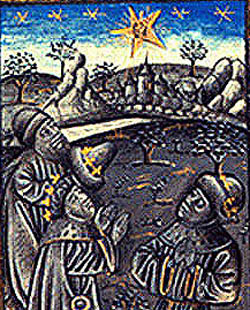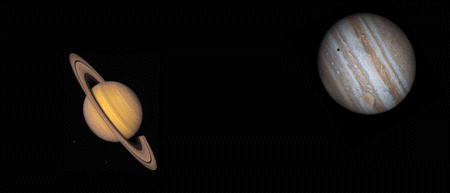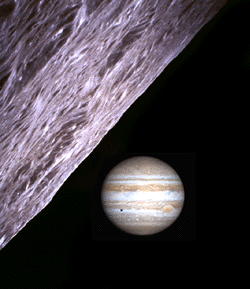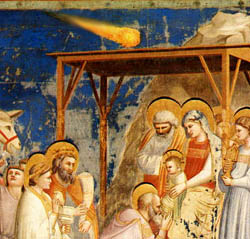|
For
two thousand years, Biblical scholars have debated the nature of
the Christmas Star. Now astronomers and other scientists are weighing
in.
by Nigel Henbest
This month, it's impossible to overlook the brilliant planet
Venus in the evening sky. During the Festive Season, it looks like
a gleaming lantern hanging in the west, setting more than two hours
after the Sun - a dead-ringer for the Christmas Star as it appears on our seasonal cards.
Was Venus the Star of Bethlehem? Almost certainly not - Venus makes such regular appearances as the "Morning Star" and the "Evening Star" that people observing the heavens even thousands of years ago would have been familiar with it. The Christmas Star must have been a celestial event that was truly out-of-the-ordinary.

Star of beauty, star of light - but if it was this bright, Herod would have known about it
|
To track down
the real Star of Bethlehem, we need to know roughly the date of
Jesus' birth. To confuse matters, Jesus wasn't born in the Year
Zero (which doesn't exist), or even in Year One. Thanks to a miscalculation
in the calendar by a sixth-century monk delighting in the name of
Dionysius Exiguus, Jesus was actually born several years BC. We
know also that Herod was alive at the time of the birth, and that
he died soon after an eclipse of the Moon - almost certainly in
4 BC. So what astronomical portents were hoving into view at around
that time?
We can rule out
a really brilliant exploding star - or supernova - of the kind we
see every year on our Christmas cards. Everyone in the Middle East
would have been astounded by such a sight. Yet - according to St
Matthew's gospel - neither King Herod nor his advisers
had seen
the star. When the Magi turned up in Jerusalem demanding "where
is he that is born King of the Jews?", Herod - with his authority
in danger of being undermined - "enquired of them diligently what
time the star appeared".
In addition, Chinese
astronomers were logging their own observations of the sky
at the time, and reported no brilliant supervovae. They did, however,
record two bright comets.
The first was Halley's Comet, which swings close by the Sun roughly
every 76 years. An unforgettable view of the comet in 1301 so inspired
the Italian Renaissance painter Giotto di Bondone that he used
it as the model for his "Star" in a famous Nativity scene. But the ancient Chinese saw Halley swinging by in 12 BC - too early for
the birth of Jesus.

It may have been
a comet seen in the spring of 5 BC
|
The Chinese reported
another celestial visitor early in 5 BC - a"broom star" on the borders
of the constellations Aquarius and Capricornus. Though some astronomers
think this was a nova - an explosion on a dwarf star - Colin Humphreys,
a scientist at Cambridge University, argues that it was a comet.
And Humphreys is convinced that this tailed wonder was the Star of Bethlehem.
The Chinese records show that the celestial visitor was visible
for 70 days - long enough to guide the Magi to Bethlehem. In this
case, Jesus was born in the spring of 5 BC.
But other scholars
believe that a comet doesn't fit the bill. The Magi were not kings,
but Babylonian astrologers. They didn't spend their time looking
at the sky, and logging unexpected events such as comets. Like the
astrologers of today, they were calculating the positions of the
Sun, Moon and planets, and their relations to each other. This enabled
them to "predict" events months or even years in advance.
Before people knew what the stars and planets actually were, they put their faith in the movements of heavenly bodies. The "wise men" who could predict those movements became incredibly powerful, because human destiny lay in their hands.
So, the Christmas Star may have been something much more subtle
- so arcane that it may not have been evident to those without the astrological knowledge...
In recent years, various scientists have tried to reinterpret the evidence, while entering into the mindset of the astronomer-astrologers of 2000 years ago, to find out what heavenly apparitions would have been important for them. David Hughes, of Sheffield University, cites a "triple conjunction" between the giant planets Jupiter and Saturn that took place in 7 BC. In May, September and December of that year, the two planets drew close together in the sky.

It may have been a triply-repeated close approach
of Saturn and Jupiter in 7 BC
|
Astrologically, the conjunctions were laden with meaning. Jupiter was the king of the gods, Saturn represented both Palestine and the principle of justice, while Pisces was the zodiacal sign of the Jewish people. The Magi - looking at their astrological charts - would have interpreted the conjunctions as a sign that a Jewish Messiah would soon be born. Hughes concludes that Jesus was born in the autumn of 7 BC.
It may have been
a case of the Moon hiding Jupiter...

|
American astronomical historian Michael Molnar has come up with even more spectacular astrological perspective. Molnar has checked out the astrological charts for the last decade BC, looking for strange configurations that would have excited the Magi. And he hit pay-dirt with the chart for 17 April 6 BC. On that date, Jupiter - the king of the planets - was rising just before the Sun. This significant event was known to ancient astrologers as "rising in the east" - just as we read in the Bible. And, simultaneously, the moon moved right in front of Jupiter. Such occultations are very rare, and astrologically extremely important.
So this date marked the birth chart of someone extremely important - not just a king, but the Messiah. In the chart, the sign of Aries was picked out by the Sun and Venus, the planet of love and hope. And to astrologers, Aries represented the kingdom of Judaea.
According to Molnar, that's why the Magi were inspired to trek across the desert to the capital of Judaea, Jerusalem, to enquire after the birth of the Messiah. Once there, they heard prophecies of the Messiah's birth in Bethlehem. On this reckoning, Jesus was born in the spring of 6 BC.

Whatever it was, the
Christmas Star has inspired great art - such as this Nativity
by Giotto di Bondone
|
So - was the Nativity
in the autumn of 7 BC, in the aftermath of a triple conjunction
of Jupiter and Saturn; in the spring of 6 BC, presaged by an occultation
of Jupiter by the Moon; or in the spring of 5 BC, heralded by a
comet?
Or was the whole
event was perhaps just an embellishment to the story of Jesus. The
star is, in fact, mentioned in only one of the four Gospels. St
Matthew must have been aware of an Old Testament prediction that
the birth of the Messiah would be accompanied by a portent in the
sky - "there shall come a Star out of Jacob" (Book of Numbers) -
and so it may have been natural to ensure that his account included
a magnificent Star of Bethlehem.
|
